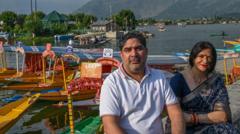**This year's Hajj pilgrimage sees enhanced precautions due to last year’s tragic heatwave, with a focus on health and safety for participants under extreme conditions.**
**Saudi Arabia Implements Heat Safety Measures for Hajj Pilgrims**

**Saudi Arabia Implements Heat Safety Measures for Hajj Pilgrims**
**As over 1.4 million pilgrims gather in Mecca, the Saudi government enforces strict regulations to prevent heat-related fatalities.**
As the sacred Hajj pilgrimage commences in the holy city of Mecca, Saudi Arabia has intensified efforts to protect the safety and health of more than 1.4 million Muslim pilgrims. In response to the shocking 1,300 deaths attributed to extreme heat last year, authorities have introduced stringent regulations and improvements aimed at minimizing heat-related risks.
To combat the forecasted temperatures soaring to 44°C (111°F), Saudi officials have planted thousands of trees and installed over 400 cooling units throughout the city. The government is also enforcing a ban on children under the age of 12 from participating in the pilgrimage. Additionally, pilgrims without official permits face heavy penalties, including a $5,000 fine and a decade-long entry prohibition, with over 269,000 individuals already denied access to Mecca as of Sunday.
Last year, a large portion of the fatalities occurred among unregistered pilgrims who lacked access to fundamental amenities such as air-conditioned accommodations and reliable transport when faced with record temperatures surpassing 51°C. Many Muslims seeking to fulfill their Hajj obligations often find official packages, priced between $4,000 and $20,000 depending on various factors, to be out of reach, prompting some to attempt the journey on tourist visas.
During the first day of Hajj, male participants donned two white cloth garments, symbolizing their spiritual readiness, while female pilgrims dressed modestly, covering their heads but not their faces. The initial rituals include circling the Kaaba at the Grand Mosque—considered Islam's holiest site—and traversing the distance between the hills of Safa and Marwa, a practice known as sai. Following these rituals, participants will camp in Mina before their ascent to Mount Arafat, where the Prophet Muhammad is believed to have delivered his final sermon.
To further safeguard the health of pilgrims, the Saudi health ministry has launched initiatives encouraging hydration and recommending protection from direct sunlight during peak hours from 10:00 AM to 4:00 PM. Enhancements to shaded areas have increased by approximately 50,000 square meters (12 acres), with the world’s largest cooling system implemented at the Grand Mosque. Furthermore, advanced technology, including artificial intelligence and drones, is being deployed to help manage crowds efficiently.
While Hajj remains a vital pillar of Islam, the steps taken this year reflect a much-needed emphasis on the well-being of pilgrims amidst ongoing safety concerns.




















